Say Goodbye to Back Pain: Master These 11 Yoga Poses for a Stronger Back
Say Goodbye to Back Pain: Master These 7 Yoga Poses for a Stronger Back By: Yoga Buddy
Understanding the Causes of Lower Back Pain
According to Health Policy Institute, nearly 65 million Americans report experiencing back pain, with most individuals reporting lower back pain at some point in their lives. It is commonly a result of poor posture, muscle imbalances, or sitting at a desk for prolonged periods of time. Understanding the root causes of lower back pain is crucial in finding effective treatments to relieve the pain. In many cases, the pain is a result of weak and tight muscles, especially in the lower back and hips. By strengthening and stretching the muscles that support and stabilize the spine yoga plays a crucial part in alleviating lower back pain.
The Benefits of Using Yoga for Lower Back Pain Relief
Yoga has gained astounding popularity as a natural and effective way to manage lower back pain. Unlike other forms of exercise, yoga combines physical postures, breathing techniques, and mindfulness, making it a comprehensive approach for back pain relief. It helps to improve flexibility and mobility in the spine, reducing stiffness and promoting an increased range of motion. Furthermore, yoga builds strength in the core, hips, and glutes, which are essential for maintaining a strong stabilized lower back. Lastly, the relaxation and stress-reducing aspects of yoga can help alleviate tension and anxiety, which are common side effects of back pain.
Preparing for Your Yoga Practice
Before practicing yoga poses, it is important to prep your body for the practice. Begin by finding a quiet and comfortable space where you can focus without distractions. You will want to wear clothing that allows for unrestricted movement. Gather any props you may need, such as a yoga wheel, yoga mat, blocks, and/or a bolster. Take a few minutes to center yourself and set an intention for your practice. It could be as simple as wanting to relieve pain or to improve your flexibility. Remember to listen to your body throughout the entire practice and modify or skip any poses that cause discomfort. Set the practice at your own pace and take time to go through the motions.
Important Safety Tips for Practicing Yoga with Lower Back Pain
While yoga can be incredibly beneficial for relieving lower back pain, it is essential to be mindful of the exercises you are performing. Here are some important safety tips to keep in mind:
- Consult with a healthcare professional: If you have chronic or severe back pain, it's crucial to seek guidance from a healthcare professional before starting your yoga practice.
- Start slow and gradually increase intensity: Begin with gentle stretches and poses, gradually progressing to more challenging ones as your body becomes stronger and more flexible.
- Focus on proper alignment: Pay close attention to your alignment during each pose. Engage your core muscles to support your lower back and avoid straining or overstretching.
- Listen to your body: If a pose causes pain or discomfort, back off or modify it. It's important to honor your body's limitations and not push beyond what feels safe and comfortable.
- Breathe deeply and mindfully: Deep, controlled breathing helps relax the body and mind, reducing tension and promoting a sense of calm during the practice.
Yoga Stretches for the Lower Back
1. Child's Pose (Balasana): Begin on your hands and knees, then sit back on your heels, extending your arms forward. Rest your forehead on the mat and breathe deeply into your lower back, feeling a gentle stretch.
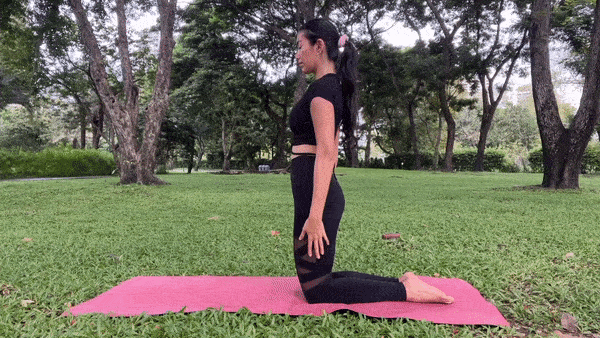
2. Cat-Cow Pose (Marjaryasana-Bitilasana): Start in a tabletop position with your hands under your shoulders and knees under your hips. Inhale, arch your back, and lift your tailbone and gaze towards the ceiling (Cow Pose). Exhale, round your spine, tuck your tailbone, and bring your chin to your chest (Cat Pose). Repeat this flowing movement several times.
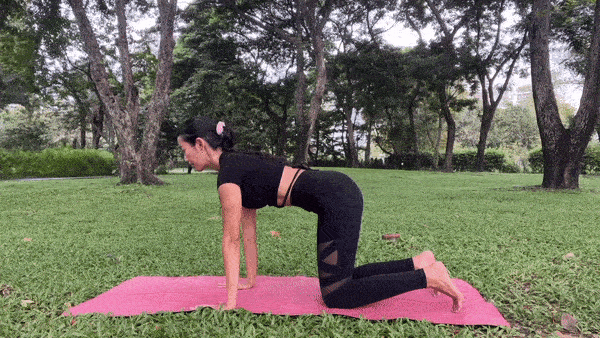
3. Downward-Facing Dog (Adho Mukha Svanasana): From a tabletop position, tuck your toes, lift your hips, and straighten your legs. Press your palms into the mat and lengthen your spine. Feel a deep stretch in your hamstrings and lower back.
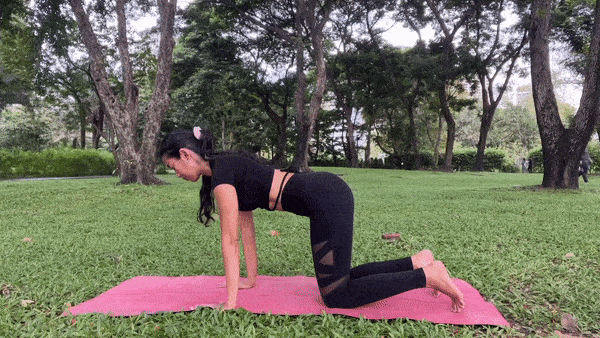
4. Standing Forward Bend (Uttanasana): Stand with your feet hip-width apart, then fold forward, bringing your hands to the ground or resting them on your shins. Allow gravity to gently stretch your lower back and hamstrings.
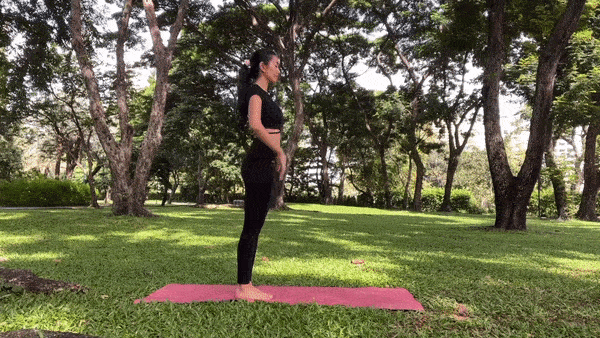
5. Bridge Pose (Setu Bandha Sarvangasana): Lie on your back with your knees bent and feet hip-width apart. Press your feet into the mat, lift your hips, and interlace your fingers under your pelvis. This pose strengthens the glutes and lower back while opening the chest.

6. Sphinx Pose (Salamba Bhujangasana): Lie on your stomach with your elbows under your shoulders and forearms flat on the mat. Press your forearms into the ground, lift your chest, and elongate your spine. Feel a gentle stretch in your lower back.
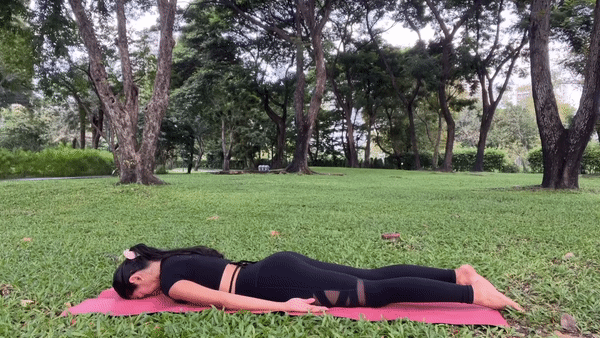
7. Supine Spinal Twist (Supta Matsyendrasana): Lie on your back, hug your knees into your chest, and then drop them to one side. Extend your arms out to the sides, keeping your shoulders grounded. This twist releases tension in the lower back and stretches the spine.
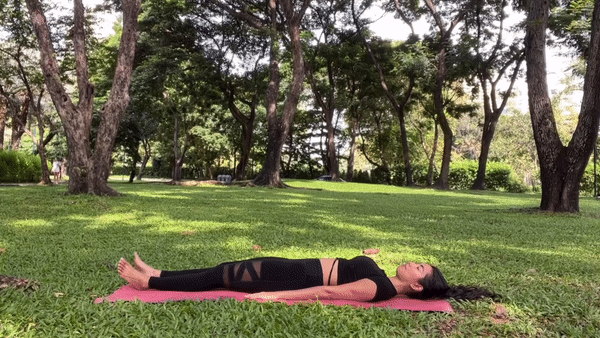
Modifying the Poses for Beginners or Individuals with Limited Flexibility
If you're new to yoga or have limited flexibility, it's important to modify the poses to suit your needs. Here are some modifications you can try:
- Use props: Utilize yoga wheels for back pain relief, blocks, or bolsters to support your body and make poses more accessible. For example, place a block under your hands in Downward-Facing Dog to reduce strain on the lower back.
- Bend your knees: If straightening your legs fully in poses like Standing Forward Bend or Downward-Facing Dog is challenging, keep a slight bend in your knees to ease the stretch on your lower back.
- Take a wider stance: When practicing standing poses, such as Standing Forward Bend or Downward-Facing Dog, widening your stance can provide more stability and allow for a deeper stretch.
- Use a chair: If getting down on the floor is difficult, perform seated or standing poses with the support of a chair. For example, seated twists can be done by turning in the chair while holding onto the backrest.
Incorporating These Yoga Stretches into Your Daily Routine
To maximize the benefits of these yoga stretches, it's important to incorporate them into your daily routine. Here are some tips to help you make it a consistent practice:
- Set a specific time: Choose a time of day that works best for you, whether it's in the morning to energize your body or in the evening to wind down and relax.
- Start small: Begin with just a few minutes of yoga stretches each day and gradually increase the duration as you become more comfortable and confident.
- Create a dedicated space: Designate a quiet and clutter-free area in your home where you can roll out your mat and practice without distractions.
- Find accountability: If you struggle with consistency, consider joining a yoga class or finding a yoga buddy to keep you motivated and accountable.
- Listen to your body: Some days, your body may need more rest or gentle stretching. Be flexible with your routine and adjust it based on how you're feeling.
Bonus Yoga Poses and Exercises That Can Help Strengthen the Lower Back
In addition to the specific yoga stretches mentioned earlier, there are other poses and exercises that can contribute to a stronger lower back. Here are a few worth exploring:
- Cobra Pose (Bhujangasana): Lie on your stomach, place your hands under your shoulders, and lift your chest off the ground. This pose strengthens the back muscles and improves spinal flexibility.
- Locust Pose (Salabhasana): Lie on your stomach, extend your arms alongside your body, and lift your chest, legs, and arms off the ground. This pose targets the muscles in the lower back and helps improve posture.
- Bird Dog Pose: Begin on your hands and knees, then extend your right arm forward and your left leg back. Engage your core to stabilize your spine. Slowly switch sides, extending your left arm and right leg.
- Pelvic Tilts: Lie on your back with your knees bent and feet flat on the ground. Gently tilt your pelvis forward and backward, focusing on the movement in your lower back. This exercise strengthens the core and stabilizes the lower back.
Additional Tips for Preventing and Managing Lower Back Pain
While yoga stretches can be incredibly beneficial for lower back pain relief, incorporating these additional tips into your lifestyle can further prevent and manage discomfort:
- Maintain good posture: Practice proper posture throughout the day, whether you're sitting, standing, or walking. This reduces strain on the lower back and promotes a healthy alignment.
- Engage in regular exercise: In addition to yoga, engage in regular cardiovascular exercise and strength training to keep your entire body strong and healthy.
- Take breaks from prolonged sitting: If you have a sedentary job, take breaks to stand, stretch, and walk around at regular intervals to avoid putting excessive strain on your lower back.
- Lift with proper technique: When lifting heavy objects, use your legs and not your back. Bend your knees, keep your back straight, and lift from a stable position.
- Manage stress: Stress can exacerbate lower back pain. Incorporate stress-management techniques into your routine, such as deep breathing exercises, meditation, or engaging in activities you enjoy.
Lastly, if you're looking for a deeper stretch our yoga wheels are a great way to relieve back pain and help to improve your stretching mobility!
Conclusion
Lower back pain can significantly impact your quality of life, but with the help of yoga stretches, you can find pain relief and build a stronger lower back. By understanding the causes of lower back pain, incorporating safe yoga practices, and gradually increasing your flexibility and strength, you can say goodbye to back pain. Remember to listen to your body, be patient with yourself, and make these yoga stretches a regular part of your daily routine. With dedication and consistency, you'll soon experience the benefits of a stronger and healthier lower back.
CTA: Start your journey to a stronger lower back today by incorporating these yoga stretches into your daily routine. Share this article with a friend who needs to see it. Remember to consult with a healthcare professional if you have chronic or severe back pain. With consistent practice and mindful alignment, you can say goodbye to back pain and enjoy a pain-free life.
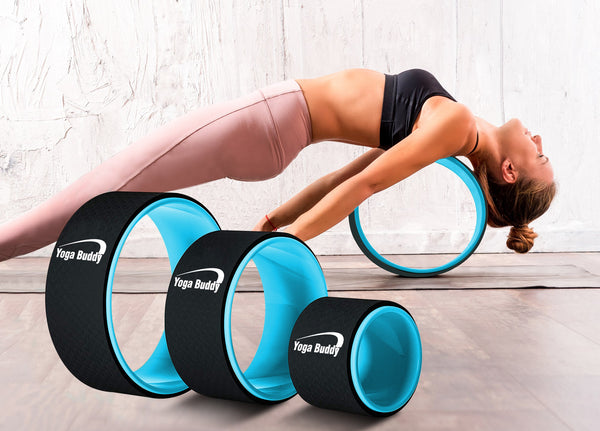
Leave a comment